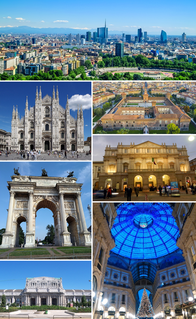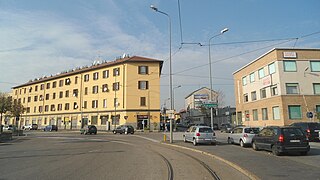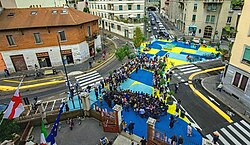
Milan is a city in northern Italy, capital of Lombardy, and the second-most populous city proper in Italy after Rome. The city proper has a population of about 1.4 million, while its metropolitan city has 3.26 million inhabitants. Its continuously built-up urban area, that stretches well beyond the boundaries of the administrative metropolitan city and into Switzerland, is the fourth largest in the EU with 5.27 million inhabitants. According to national sources, the population within the wider Milan metropolitan area, is estimated between 8.2 million and 12.5 million making it by far the largest metropolitan area in Italy and one of the largest in the EU.

Brianza is a geographical, historical and cultural area of Italy, at the foot of the Alps, in the North-West of Lombardy, between Milan and Lake Como.

Brugherio is a comune (municipality) in the Province of Monza and Brianza in the Italian region Lombardy, located about 10 kilometres northeast of Milan. It was established December 9, 1866 unifying the suppressed municipalities of Baraggia, San Damiano and Moncucco, together with the villages of Bindellera, Cesena, Gelosa, San Paolo, Torazza, Occhiate and Increa.

Raffaele La Capria is an Italian novelist and screenwriter.

Corso Buenos Aires is a major street in north-eastern Milan, Italy. With over 350 shops and outlets, it features the highest concentration of clothing stores in Europe. The architecture of the area is mostly late 19th- and 20th-century style; the street and its surroundings are pointed with several neo-classical and art nouveau buildings.

Villa Sciarra is a park in Rome named for the villa at its centre. It is located between the neighborhoods of Trastevere, Gianicolo and Monteverde Vecchio.
Roserio is a district ("quartiere") of Milan, Italy, part of the Zone 8 administrative division of the city. It is the northernmost district, bordering on the comune of Baranzate. Before being annexed to Milan, it has been an autonomous comune, as well as part of Bollate and of Musocco.

Via Cristoforo Colombo is a street in Rome (Italy) that links the historic centre to Ostia. Along most of its route, the street has three lanes for each direction of movement. With its 27 kilometres (17 mi) length it is the longest Italian road among those included within the borders of a single municipality and, in several stretches, the largest in Italy.

The Zone 2 of Milan is one of the 9 administrative zones of Milan, Italy. In the "sunburst" geometry of the zones of Milan, Zone 2 is the slice that connects the centre to the periphery in the north-east direction.
Cascina Torchiera is a historic cascina a corte (farmhouse) of Milan, Italy, dating back to the first half of the 14th century. It is located in zone 8 of Milan, adjacent to the Maggiore cemetery, in the Musocco/Garegnano district, and is one of the oldest surviving cascine within the city boundaries. The cascina is formally the property of the Comune di Milano city administration and has been a squatted self-managed social centre since the 1992. It is known as Cascina Autogestita Torchiera SenzAcqua.
The following is a timeline of the history of the city of Milan, Italy.

Quartiere Varesina is a small district, quartiere, of Milan, located in the suburban north-west part of the city. It belongs on the Zone 8 administrative division of the city.
Angelo Torricelli is an Italian architect.

Saint Lucius in Brugherio, Italy, is a small church dedicated to Saint Lucius in the grounds of the Villa Sormani. First located in Lugano, Switzerland, where it was a Franciscan chapel, the building was disassembled and transported to Brugherio where its reconstruction was completed 17 years later.

San Vittore is a prison in the city center of Milan, Italy. Its construction started in 1872 and opened on 7 July 1879. The prison has place for 600 inmates, but it had 1036 prisoners in 2017.
The old farmhouses of Brugherio were agricultural structures typical of the Po-Valley in Lombardy, which gave its name to the surrounding areas as well, roughly corresponding to fractional towns in which Brugherio was divided. The union of the various small rural municipalities in which the territory was fragmented gave birth in 1866 to the municipality of Brugherio. Some are still visible: Bindellera, Casecca, Cattoni, Comolli, Dorderio, Guzzina, Increa, Modesta, Moia, Occhiate, Pareana, San Cristoforo, Sant'Ambrogio, San Paolo and Torazza.

Stolpersteine is the German name for small, cobblestone-sized memorials placed around Europe by the German artist Gunter Demnig. They commemorate the victims of Nazi Germany who were murdered, deported, exiled or driven to suicide. The first Stolpersteine in Milan, the capital of the Italian region of Lombardia, were established in January 2017.

The Università Popolare degli Studi di Milano is an unaccredited diploma mill using the word university in its name, located in Milan, Italy.

Eugenio Gerli was an Italian architect and designer. In an intense working life spanning more than six decades, Eugenio Gerli explored many different areas of his profession. He built villas, apartment blocks, office blocks, factories, banks and stores, and also restored historic buildings. He often completed his works with custom-made interiors and furniture.This diverse range of projects inspired his industrial design and today many have become icons, like the S83 chair, the PS 142 armchair Clamis, the Jamaica cabinet and the Graphis System.

Eugenio Soncini was an Italian architect.



















